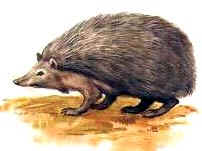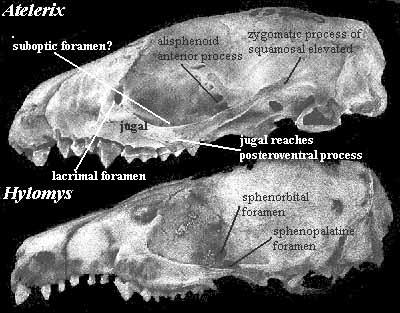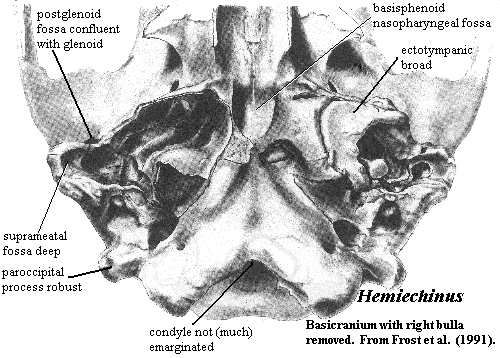 Erinaceinae: hedgehogs) Atelerix, Erinaceus, Hemiechinus, Mesechinus, Paraechinus
Erinaceinae: hedgehogs) Atelerix, Erinaceus, Hemiechinus, Mesechinus, Paraechinus| Insectivora | ||
| The Vertebrates | Erinaceinae |
| Vertebrates Home | Vertebrate | Vertebrate |
|
Abbreviated Dendrogram
Eutheria
│
├─Insectivora
│ ├─Micropternodontidae
│ └─┬─Erinaceomorpha
│ │ ├─Hylomyinae
│ │ └─Erinaceinae
│ └─Soricomorpha
│ ├─Tenrecoidea
│ └─┬─Solenodontidae
│ └─┬─Talpoidea
│ └─Soricoidea
│ ├─Apternodontidae
│ └─Soricidae
│ ├─Crocidurinae
│ └─Soricinae
└─┬─Chrysochloroidea
└─Afrotheria
|
Contents
Index |
 Erinaceinae: hedgehogs) Atelerix, Erinaceus, Hemiechinus, Mesechinus, Paraechinus
Erinaceinae: hedgehogs) Atelerix, Erinaceus, Hemiechinus, Mesechinus, Paraechinus
Range: Europe, North Africa, Russia & South Asia.
Phylogeny: Erinaceomorpha: Hylomyinae + *.
 Characters: rostrum short (< 35% skull length) [F+91$]; nasals reaching level of orbital rim [F+91$]; frontal at least slightly inflated [F+91$]; antorbital fossa absent [F+91$]; lacrimal foramen visible in lateral view, with anterior flange poorly developed [F+91]; suboptic foramen reaches medial wall of "sphenorbital transverse torus" [F+91$?]; "sphenopalatine foramen decidedly posterodorsal to palatine transverse torus" [F+91$]; jugal small, reaching posteroventral process of zygomatic arch, but not reaching lacrimal [F+91$?]; squamosal, zygomatic process elevated [F+91$]; postglenoid foramen confluent with glenoid [F+91$]; paroccipital process robust [F+91$]; occipital condyle not emarginated [F+91$]; hearing acute [N99]; suprameatal fossa present [F+91$]; ectotympanic broad [F+91$]; stapedial fossa adjacent to postglenoid foramen [F+91$]; epitympanic recess formed by mastoid [F+91$]; basisphenoid with deep, distinctive nasopharyngeal fossa [F+91$]; alisphenoid, orbital wing, with anterior process [F+91$]; palatine, anterior foramina elongated to include middle foramina [F+91$]; I2 ≤ I3 [F+91$]; I3 with 2, separate roots [F+91$]; i1 absent [F+91$]; i2 much larger than other incisors [F+91$]; C1 same size as adjacent teeth [F+91$]; P3 with well-developed lingual lobe [F+91$?]; p3 absent [F+91$?]; M1 lingual roots largely fused [F+91$]; M3 with 2 roots [F+91$]; M3 hypocone & metacone absent [F+91$]; m3 talonid absent [F+91$]; axis neural spine low [F+91$?]; axis without posteroventral keel [F+91]; sacral vertebrae not fused into longitudinal plate [F+91$] [2]; scapula, metacromion process deltoid & amorphous [F+91$?]; ischium without elongate posteroventral process [F+91]; tibia without strongly developed lateral flange [F+91]; barbless spines (adults have an average of 5000) on back & flanks [F+91$] [N99]; with rest of body covered in coarse hair [N99] [V+00]; mm panniculus carnosus well developed to raise spines [V+00]; nocturnal insectivore/carnivores [N99] [V+00]; commonly climb and swim reasonably well, but ambulate slowly [N99]; heterothermy and torpor
Characters: rostrum short (< 35% skull length) [F+91$]; nasals reaching level of orbital rim [F+91$]; frontal at least slightly inflated [F+91$]; antorbital fossa absent [F+91$]; lacrimal foramen visible in lateral view, with anterior flange poorly developed [F+91]; suboptic foramen reaches medial wall of "sphenorbital transverse torus" [F+91$?]; "sphenopalatine foramen decidedly posterodorsal to palatine transverse torus" [F+91$]; jugal small, reaching posteroventral process of zygomatic arch, but not reaching lacrimal [F+91$?]; squamosal, zygomatic process elevated [F+91$]; postglenoid foramen confluent with glenoid [F+91$]; paroccipital process robust [F+91$]; occipital condyle not emarginated [F+91$]; hearing acute [N99]; suprameatal fossa present [F+91$]; ectotympanic broad [F+91$]; stapedial fossa adjacent to postglenoid foramen [F+91$]; epitympanic recess formed by mastoid [F+91$]; basisphenoid with deep, distinctive nasopharyngeal fossa [F+91$]; alisphenoid, orbital wing, with anterior process [F+91$]; palatine, anterior foramina elongated to include middle foramina [F+91$]; I2 ≤ I3 [F+91$]; I3 with 2, separate roots [F+91$]; i1 absent [F+91$]; i2 much larger than other incisors [F+91$]; C1 same size as adjacent teeth [F+91$]; P3 with well-developed lingual lobe [F+91$?]; p3 absent [F+91$?]; M1 lingual roots largely fused [F+91$]; M3 with 2 roots [F+91$]; M3 hypocone & metacone absent [F+91$]; m3 talonid absent [F+91$]; axis neural spine low [F+91$?]; axis without posteroventral keel [F+91]; sacral vertebrae not fused into longitudinal plate [F+91$] [2]; scapula, metacromion process deltoid & amorphous [F+91$?]; ischium without elongate posteroventral process [F+91]; tibia without strongly developed lateral flange [F+91]; barbless spines (adults have an average of 5000) on back & flanks [F+91$] [N99]; with rest of body covered in coarse hair [N99] [V+00]; mm panniculus carnosus well developed to raise spines [V+00]; nocturnal insectivore/carnivores [N99] [V+00]; commonly climb and swim reasonably well, but ambulate slowly [N99]; heterothermy and torpor  or hibernation common [N99] [V+00]; characteristic defensive behavior curling into ball & erecting spines) [N99]; common distress vocalizations, including snake-like hiss & loud cry [N99].
or hibernation common [N99] [V+00]; characteristic defensive behavior curling into ball & erecting spines) [N99]; common distress vocalizations, including snake-like hiss & loud cry [N99].
Note: [1] range expanding northward in Russia and Scandinavia, but range also expanding in Iran. See abstract at Zoology in the. [2] Frost et al. [F+91] contradicts themselves here, stating both that the sacrals are and are not fused in erinaceines. Unfused sacrals seem more probable from context, if less probable from a functional standpoint (more heavily armored forms typically do have fused sacrals).
Image: Atelerix & Hylomys skulls in left lateral view. Modified from [F+91].
Links: APUS.RU | Еж даурский Russian: natural history, with an interesting note that its range in Russia is expanding northwards); Erinaceinae Mikko's phylogeny); Stacheligel German: mostly diversity and reproduction); Eurasian Insectivores and Tree Shrews - Status Survey and ... diversity & distribution); Animal Diversity Web: Erinaceidae Family-- very good genus level coverage of natural history, habits, ecology and some anatomy); Aus dem Institut für Pathologie der Tierärztlichen Hochschule ... hedgehog pathology and veterinary medicine); Wild Natures - Homepage OK, we admit that this has nothing to do with hedgehogs -- but wouldn't it be fun?); Olga V. Zherebtsova. Spiny cover and defence strategy of mammals ... an interesting little article on the use of spines as defense in various mammals); ZOOGDIEREN a little natural history, but mostly etymology); Taxonomy browser (Erinaceinae) NCBI); hedgehog (mostly species accounts and links).
References: Frost et al. 1991) [F+91]; Nowak (1999) [N99]; Vaughan et al. 2000) [V+00]. ATW030726.
checked ATW050623